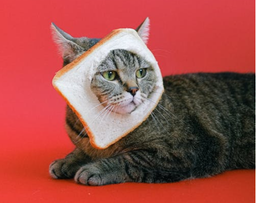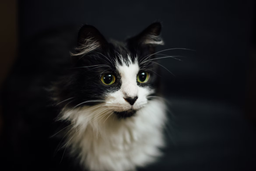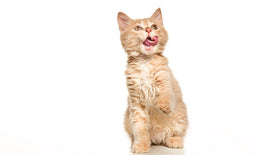Can cats eat pasta? Learn all about the proper diet for your feline
Garfield eats lasagna all the time, and it doesn’t seem to damage his health. He’s only chubby, but what does it matter—he’s cute. The reality is not so cute because spaghetti, lasagna, or any tasty pasta are not ideal food options for your kitty.
Can cats eat pasta at all? Untamed is here to answer this question and explain the pros (if there are any) and cons of feeding pasta to your feline companion. We will also tell you about the healthiest food for your furry friend, i.e. what cats should and shouldn’t eat to stay healthy.

Pasta is the favourite dish of many cat parents, but is it safe for felines?
Source: Danijela Prijovic
What’s in pasta?
The most common pasta ingredients are wheat flour, eggs, salt, and water. Pasta can also contain rice, lentils, zucchini, and beans, commonly used for making gluten-free pasta.
The product is full of carbohydrates, with 43 grams of carbs in 140 grams of pasta. Check out the table below to discover what other nutrients you’ll find in an average serving:
|
Nutrients |
Amount of nutrients in 140 grams of pasta |
|
Calories |
221 |
|
Fat |
1.3 grams |
|
Sodium |
1 milligram |
|
Fibre |
2.5 grams |
|
Sugar |
0.8 grams |
|
Protein |
8.1 grams |

Did you say pawsta? I wanna try some, please hooman.
Source: Pexels
Do cats eat pasta, and should they?
Cats are obligate carnivores, so they should get their energy from animal proteins and fats. Carbohydrates are unnecessary in a cat’s diet and can cause problems with their digestive tract. Pasta is packed with carbs, so it shouldn’t be a regular product in your feline friend’s diet. Cats can eat pasta, but it doesn’t provide the essential nutrients that kitties need to thrive.
Like bread, pasta is a source of empty calories, as it doesn’t contain any of the vitamins, minerals, or amino acids crucial for feline health. Feeding pasta to your furry friend can lead to:
Obesity
Cats in the wild hunt and eat small animals, such as rodents, birds, and insects. Their prey is high in protein, moderate in fats, and has almost no carbohydrates. Indoor cats’ diet should follow this pattern when it comes to the necessary nutrients.
If pasta were to become a regular part of your feline’s diet, it would do more harm than good because of the calorie surplus. Since your cat’s digestive tract is adept at processing protein and fat (in moderation), a diet full of carbs may lead to obesity in felines.
Check out the table below to see the optimal nutrient ratio in a cat’s diet:
|
Nutrient |
Recommended amount |
|
Protein |
Over 50% |
|
Fat |
Up to 20% |
|
Carbohydrates |
Less than 3% |
Obesity significantly shortens your cat’s lifespan and can cause other health issues, including:
- Diabetes
- Hypertension
- Heart disease
- Cancer
- Joint problems and arthritis
Gastrointestinal issues
Your cat’s digestive system is sensitive, and it cannot break down the starch in pasta, which leads to gastrointestinal issues, such as:
- Vomiting
- Diarrhoea
- Constipation
- Loss of appetite
- Irritable bowel syndrome
- Abdominal pain
If you notice any of the symptoms of gastrointestinal distress, stop feeding pasta to your feline companion and consult your veterinarian.
Allergic reactions
Gluten can trigger allergic reactions in some cats, and pasta is full of it. Monitor your kitty for any of the following symptoms:
- Weight loss
- Asthma
- Vomiting
- Dry or irritated skin
- Hives
- Diarrhoea
- Constant scratching
Your cat may also be allergic, intolerant, or sensitive to grain, which means they won’t be able to process plant-based products. You should opt for a grain-free diet for your feline. As cats can’t absorb nutrients from plants, veganism is not a viable option if you want to keep your furry companion healthy and happy.

Let me just lick the remaining pasta off my paw.
Source: TeamK
Cat eating pasta—how dangerous is it?
If your kitty got a hold of some freshly cooked spaghetti without sauce, you don’t need to panic—they will probably be able to digest it. If your furball feasted on pasta with sauce, be cautious because some popular ingredients are toxic to cats.
The basis of most sauces is butter or olive oil, and both can cause gastrointestinal issues. As cats tend to be lactose intolerant, dairy products, such as cheese, can be difficult to digest. Although milk and olive oil don’t pose an immediate danger for your cat, other popular sauce ingredients do.
Check the label for the following:
- Garlic and onions
- Alcohol
- Chocolate
Garlic and onions
Garlic and onions are highly toxic to cats as they can damage your furry friend’s red blood cells and lead to anaemia. These allium vegetables cause severe toxicosis. Symptoms of poisoning include:
- Lethargy
- Weakness
- Loss of appetite
- Orange to dark red urine
Alcohol
Some sauces contain wine, and alcohol is highly toxic to cats. It can lead to liver and kidney failure. Since wine is made from grapes, it is even more dangerous for your furry friend because grapes are poisonous to felines.
Grapes and raisins can lead to complete kidney failure in three days. The symptoms of toxicosis appear within 24 hours after consumption, so if you take your kitty to the vet immediately, they can fully recover.
Chocolate
Some cat parents enjoy a bowl of sweet spaghetti every once in a while, but cats should never have sugar, while chocolate is especially harmful. Chocolate contains theobromine and caffeine, which can be lethal. Symptoms of chocolate poisoning include:
- Tremors
- Seizures
- Abnormal heart rhythm

I’m waiting for some delicious pasta. Feed me, hooman!
Source: Marko Blazevic
Can cats eat noodles if spaghetti is a no-no?
Noodles are a healthier alternative for cat parents, but the same cannot be said for their feline friends. The product is often made from rice or potatoes, which are not appropriate for cats. Felines don’t thrive on a grain-rich diet because they should get their calories from animal protein.
If you want to share some noodles with your furry friend—think again. Not only are they unhealthy for your cat, but they can be harmful. Instant noodles usually contain high levels of sodium, which, if consumed in large amounts, can lead to high blood pressure, bladder stones, cystitis, and kidney failure. Other harmful ingredients in noodles are garlic and onion powder, chilli, and palm oil.
Cats don’t have amylase (the enzyme needed to process carbs). When their body tries to break down this nutrient, cats often experience digestion issues, like constipation, vomiting, or diarrhoea.
Can I combine pasta with cat food?
You shouldn’t combine pasta with cat food, especially if you’re already mixing wet cat food with biscuits. Kibble is high in carbohydrates, and adding pasta will only create a surplus. If your cat feels full, they won’t consume enough protein and fat, which can cause protein deficiency and trigger other health problems.
Is dry cat food better than spaghetti?
Cat kibble is more appropriate for your feline than pasta, but basing your cat’s diet entirely on dry food is also not perfect. While biscuits can be good for your kitty’s dental health (according to some vets), they are rich in carbs and lead to obesity. You should consider adding semi-moist or wet food to the mix for better results.
If you combine wet food with kibble, your cat will get enough protein, vitamins, and minerals to stay healthy. It’s also a convenient way to prevent dehydration. Fluid deficiency can lead to serious health issues, primarily urinary and digestive tract problems.
If your kitty doesn’t like the texture or taste of wet food, add some soup or bone broth to their meals.

A meat diet will agree with your furry friend’s taste and keep them healthy and happy.
Image (c) Untamed
What should your furball’s diet contain? Is wet food the best option?
A cat’s diet should consist of at least 50% animal-based protein and up to 20% fat. The following table shows the best protein sources for felines:
|
Meat |
Particular foods |
|
Poultry |
|
|
Red meat |
|
|
Fish |
|
Keep in mind that pork and beef are high in fat, so you should give them occasionally. Cured and processed meat, like ham and bacon, should be given from time to time or as taste enhancers to regular meals.
High-quality wet food contains the right amounts of protein, fat, and moisture, so it’s the best option for indoor felines. You should always check the protein source because cats cannot absorb the essential amino acids (taurine and arginine) from vegetables and grains.
Should cats eat raw or cooked meat?
Many cat parents believe that raw food and bones mimic the natural feline diet. The biologically appropriate raw food (B.A.R.F.) diet is not easy to follow and comes with numerous risks. Raw meat comes from the human supply chain, so it’s not nearly as fresh as the prey wild cats kill and eat immediately. Freezing and defrosting procedures make raw meat susceptible to various pathogens. The most common harmful bacteria in raw meat are:
- E. coli
- Salmonella
- Listeria
The risk of cross-contamination is also high, so your cat is not the only one in danger. Steaming raw chicken or any other meat will eliminate the pathogens while your cat will get all the essential nutrients. If you decide to put your feline on a B.A.R.F. diet, consult your vet because it requires specific sanitary measures.

Untamed has it all—healthy ingredients, human-grade whole meat, and the perfect taste!
Image (c) Untamed
Untamed is healthy, safe, and delicious
Untamed products tick all the right boxes when it comes to the dietary needs of cats. They are healthy and delicious, so even fussy felines cannot resist the taste. Untamed is appropriate for:
- Kittens who are still developing and need high-protein food
- Adult cats who have hairball and shedding issues
- Senior felines who are losing weight rapidly
- Toothless kitties who struggle with eating solid food
- Pregnant queens with mood swings
- Lazy neutered males
Our cat food is made from human-grade whole meat from sustainable and cruelty-free farms. Here’s what makes Untamed food so great:
- Vet-formulated recipes
- Gently cooked ingredients
- Complete and balanced formulas
- Hypoallergenic components
Vet-formulated recipes
We create our food in collaboration with veterinarians to ensure it contains all the necessary nutrients for your kitty. With our food, your cat will be happy, healthy, and energetic.
Gently cooked
Untamed food isn’t heavily processed because we don’t want to lose the taste and bioavailability of our high-quality ingredients. We are inspired by home-cooked meals, which is why cats go crazy for our delicacies.
Complete and balanced
Our food contains twice as much protein as the industry standard. We don’t use the following unnecessary fillers:
- Grains
- Meat derivatives
- Vegetables
- Taste enhancers (besides some delicious salmon or ham)
- Artificial colouring
- Harmful chemicals
Hypoallergenic
Untamed products are free of any known allergens as we use only natural ingredients and whole meat. If your kitty’s tummy is sensitive, our food is the perfect choice for them.
Take our TRY NOW quiz and treat your feline to a tasty and healthy feast.
Place your first Untamed order and see how everything changes
We have numerous clients who now swear by Untamed. Here are some positive changes they reported:
- After one week—Their furry companions had more energy and produced less mess in the litter tray. Kitties’ digestive issues were gone
- After two months—Chubby kitties started to lose weight. Dental, skin, and coat health were better, which means fewer annoying hairballs and no massive shedding
- Within four months—Cat parents noticed that their feline companions started to develop a lean physique after four months. Their digestive health became stable, and their immune system improved
- After six months and beyond—Untamed helps your kitty stay healthy, youthful, and fit. It keeps your feline safe from the early onset of age-related chronic conditions
Our food is suitable for cats of all breeds, so we cater to Persians, Siamese, Ragdolls, Bengals, Maine Coons, and British Shorthairs.

Our Chocka Chicken in Gravy is the dish your kitty will go wild for!
Image (c) Untamed
Untamed recipes are a tantalising food adventure for your cat
Healthy food doesn’t have to be bland or boring. Untamed makes power meals for the pickiest of cats. Check out some of our most popular dishes:
- Tuck-in Tuna in Jelly—Dolphin-safe gently cooked tuna served in jelly to seal the aroma
- Chocka Chicken in Jelly—This dish is ideal for kitties with sensitive tummies, made from fresh chicken breast dipped in jelly for high moisture content
- Chocka Chicken in Gravy—Hand-shredded chicken and chicken liver gently simmered in gravy, great for sensitive furballs who like their food rich and tasty
- Full-on Fishy in Gravy—If your furry friend is crazy about fish, this dish is perfect for them. Whole meat tuna, sardine, and mackerel fillets are gently cooked in natural gravy to tickle all the senses
How to get your first Untamed taster pack
To get a tailor-made starter pack of Untamed delicacies, follow the steps below:
- Take our TRY NOW quiz and tell us about your cat’s eating habits, allergies, and taste preferences
- Choose a meal plan
- Place the order
You will receive the cat food trial box within a day. If your feline friend likes our food—and we know they will—we will replenish your stock around the same time every month.
You can change, cancel, or postpone your order at any time. The monthly cat food shipping is free of cost, and the food comes in 100% recyclable packaging.
Untamed products have a shelf life of three years, and you don’t have to freeze them to keep them fresh. You also don’t need to warm them up—open the can and watch your cat jump for joy.
Can cats eat pizza?
Cats shouldn’t eat pizza because it contains potentially toxic ingredients. Garlic and onions are especially dangerous. Other ingredients, such as cheese, can cause mild digestion issues. Pizza also contains processed meats, which will be alluring to your furry friend, but cured deli meats aren’t the ideal source of animal protein. They are also high in fat, sodium, and chemical preservatives, which negatively affect your feline’s health in the long run.
Mushrooms on a pizza might also entice your cat’s appetite. They aren’t harmful to your cat, but it’s best to stick to meat as the optimal source of protein.
Can cats eat lasagna?
Your cat will probably like the smell of lasagna because of the minced meat. Unfortunately, other ingredients are not appropriate for felines. Lasagna contains not only onion and garlic, which can cause your kitty’s red blood cells to break and lead to anaemia, but also tomato sauce that contains solanine, a substance toxic to cats.
Check out our other guides to what cats can or cannot eat:
|
|

![Best food for Ragdoll cats in the UK [Broken Down]](http://untamed.com/cdn/shop/articles/featured_best_food_for_ragdoll_cats_uk.jpg?v=1646818249&width=256)

